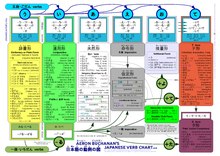
Back تصريف الأفعال اليابانية Arabic Conxugación de verbos xaponeses AST Conjugació dels verbs japonesos Catalan Ιαπωνική κλίση ρημάτων Greek Conjugación de verbos japoneses Spanish Verbe en japonais French 活用#日本語における活用 Japanese การผันรูปคำกริยาภาษาญี่ปุ่น Thai Japoncada fiil çekimi Turkish 活用 (日語) Chinese
Japanese verbs, like the verbs of many other languages, can be morphologically modified to change their meaning or grammatical function – a process known as conjugation. In Japanese, the beginning of a word (the stem) is preserved during conjugation, while the ending of the word is altered in some way to change the meaning (this is the inflectional suffix). Japanese verb conjugations are independent of person, number and gender (they do not depend on whether the subject is I, you, he, she, we, etc.); the conjugated forms can express meanings such as negation, present and past tense, volition, passive voice, causation, imperative and conditional mood, and ability. There are also special forms for conjunction with other verbs, and for combination with particles for additional meanings.
Japanese verbs have agglutinating properties: some of the conjugated forms are themselves conjugable verbs (or i-adjectives), which can result in several suffixes being strung together in a single verb form to express a combination of meanings.
